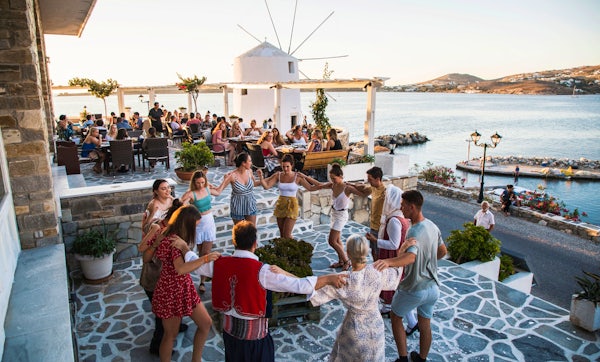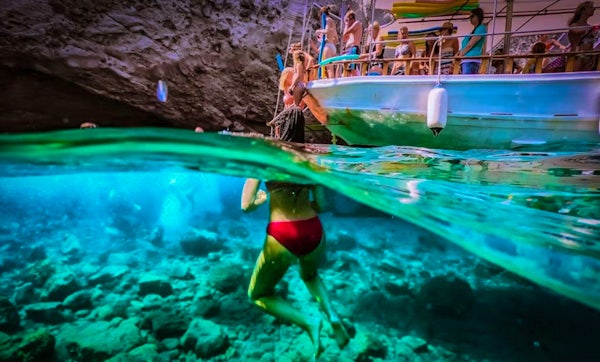Greek Island Hopping 2026

The Ultimate Greek Island Hopping Guide – Everything You Need to Know!
Greek island hopping is a once-in-a-lifetime experience. It will whisk you away to the very end of southern Europe, to a place where the land fragments into shimmering islets and bays and pine-clad mountains rise over perfectly azure seas. Tempted? Of course you are…
There are a whopping 6,000+ individual islands in Greece as a whole, so you're going to be spoiled for choice. They run the gamut from uninhabited rocks jutting from the Aegean Sea to vast lands scored by mountains and threaded with gorgeous stretches of golden sand. Each is different, too, so there's really no saying whether that next stop will be a buzzing harbour town filled with tavernas or a secret inlet where it's just you and the paint-peeling fishing skiffs.
This ultimate guide to Greek island hopping is the perfect place to begin. It offers insights into the various island groups, from the pebble coves of Ionia to the iconic isles of the Cyclades. Whether you're looking to experience the nightlife of the Greek Islands, or the rugged beauty of hiking in Greece, this guide is a great place to start. And there's practical info, too, detailing how you can get from A to B and when's the best time to visit.
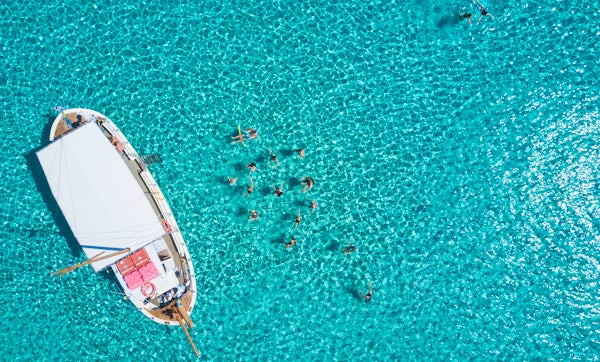
Best time to go Greek island hopping
Greek Islands in Spring
Spring is a fantastic time to go island hopping in Greece. April and May are true transition months, seeing temperatures rise from the high teens to the high twenties in just a matter of weeks. The best thing is that the summer crowds haven't yet appeared, which means it's a great opportunity to see more popular island-hopping stops – Mykonos, Santorini, Hydra – without oodles of people getting in the way.
Greek Islands in Summer
The summer is the most popular time to go island hopping in Greece. It's easy to see why: Hot weather (we're talking highs in the 40s and average temps in the 30s) and almost endless sun from June to August. Thankfully, the Ionian and Aegean seas also get good cross winds that make sailing from island to island a cinch, even for inexperienced skippers. What's more, every island on your itinerary will be in full flow when the summer months are rolling. The parties in Ios will be off the hook. The chic eateries in Mykonos will all be open. The resort hotels of Crete will be raring to go.
This is the ideal time to join one of our Greek Island Party Tours
Greek Islands in Autumn
Let's make it simple: Autumn is a downright stunning time to come to Greece. Virtually everywhere is still warm, but the mercury does slacken off a little to give more pleasant evenings. Averages are in the low- to mid-20s, and rains rarely come until the end of September. More than that, the colours on the mountains are a palette of ochre and red, while the seas are at their warmest (think 22 in the Aegean!).
Greek Islands in Winter
It's not totally impossible to go Greek island hopping in the winter. However, it won't be easy. Lots of tour providers simply don't run between November and March. The weather is often too cold and the Aegean and Ionian seas can be downright rough to boot. More than that, there's a significant drop in the number of flights connecting up the islands, so you'll be relying on pricey connections that often go via Athens, which isn't ideal. If you're determined to come in winter, we'd recommend short-haul island-hopping itineraries around the Saronic Gulf. Islands there – Hydra, Poros, Aegina – always have some life.
How to get to Greece
The first step of any island-hopping odyssey through the Greek seas is getting to Greece in the first place. Thankfully, that's pretty easy – this is one of Europe's top holiday destinations, after all. Most people will jet in on one of the many low-cost flight links that come from major hubs on the continent. However, the options are endless, with international bus and ferry connections also on the menu…
The vast majority of people will hop on a flight to get to Greece. There are hundreds of daily connections from all over Europe and beyond to this uber-popular vacation destination during the high-season months. What's more, there are more arrival points on offer than you can shake a bowl of tzatziki at, many of which get you straight out to the islands. Some of the most popular airports to land at for island hoppers are:
- Athens International Airport Eleftherios Venizelos (in Athens) - The largest airport in Greece, and a good option for long-haul flight arrivals. A train from the terminal connects with the Athens Metro system for links to Piraeus port, which is the main hub of all inter-island ferries.
- Santorini International Airport (in Santorini) - Start your island-hopping trip in style by flying straight into Santorini, one of the most dramatic spots in the Cyclades and a must on most itineraries.
- Heraklion International Airport Nikos Kazantzakis (in Crete) - The busiest, but not the only, airport on Crete, Heraklion offers a gateway to the largest Greek island of all, where mountains and ancient Minoan sites abound. Starting here means your next leg will probably be a long boat link north to the Cyclades.
- Ioannis Kapodistrias International Airport (in Corfu) - Probably the main gateway to the western islands of the Ionian Sea, Corfu's airport is perfect for exploring places like Kefalonia, Ithaka, and Zante.

One of the more romantic and timeless ways to arrive in Greece is over the seas. Sea routes linking the islands to neighbouring countries have been open for centuries, and the journey is often slow and meditative, offering views of passing Balkan coastlines by dusk or visions of the sweeping Adriatic Sea as you travel. The most popular international ferry links include:
- Ancona to Patras (18-21 hours) - Ancona sits on the main E55 motorway that runs the breadth of Italy, so it's a good embarkation point for anyone looking to hit Greece after exploring Milan, Venice or Bologna.
- Brindisi to Corfu (6.5 hours) - The fastest international ferry connection from Italy, crossing the middle of the Adriatic Sea and arriving at stunning Corfu, the perfect starting point for island hopping through Ionia.
- Marmaris to Rhodes (1 hour) - This short link takes you from the Turkish Riviera to the Greek islands in about 60 minutes, costing €40 per person on average.
- Venice to Igoumenitsa (25-26 hours) - A couple of overnight sailings per week now link the incredible UNESCO city of Venice with Igoumenitsa in north-western Greece.

Greece doesn't have a great railway system. However, there are a few international connections that you can hop on. A seasonal overnight train called the Hellas Express comes in from Belgrade throughout the summer months (June to September). There's also a connection throughout the year from Sofia in Bulgaria. All international train arrivals come into Thessaloniki in north-eastern Greece, which is a good jump-off point for hitting the Sporades Islands and the northern Aegean.

There are very good cross-continental highways connecting Greece to neighbouring countries in the Balkan Peninsula. There are a few good places to aim for if you're keen to get on the boats and out to the islands ASAP:
- Thessaloniki (for islands: Limnos, Alonissos, Skopelos) - By far the best-connected city in Greece, with road links to Skopje in North Macedonia in 2 hours and 50 minutes and to Sofia in Bulgaria in 3.5 hours.
- Athens (for virtually all islands bar the Ionian region) - The drive to Athens will take more time than to Thessaloniki, but opens up the ferry services of Piraeus port, which link all over, from Crete to Rhodes and everything in between.
- Igoumenitsa (for the Ionian islands) - Igoumenitsa is close to Albania but the roads are pretty bad between the two. Expect long drive times to this gateway to the westernmost islands of Corfu, Kefalonia and Paxos.

How to hop from island to island
You've got two choices when it comes to planning your Greek island-hopping trip. You can either book onto a planned tour or go it alone. The first option keeps things simple. All you gotta' do is turn up, crack a Mythos beer, and settle in for the ride. The second option calls for a bit more organising, especially as you need to sort out getting from one island to the next. There are only really two options for that, though:
Greek island ferries
Greece has one of the most comprehensive ferry networks in the world. There are long-haul overnight boats that connect major destinations right down to tiny inter-island ferries that are no more than glorified fishing skiffs. Athens is very much the hub of the whole thing. Its huge – and ancient – port at Piraeus is the meeting point for most of the boats going across the Aegean Sea, as far as Rhodes and as close as Aegina. Other port towns offer steppingstones to different parts of Greece, like Igoumenitsa for the Ionian Islands and Thessaloniki for the northern Aegean.
On top of that, every individual island group usually has its own 'mini hub'. That allows for quick transfers onto smaller boats to lesser-known islands, for example from Paros (the mini hub of the Cyclades) to untrodden Koufonisia. It's always a good idea to plan island-hopping routes by looking at the map and checking the ferry links in that particular region. Picking stops along the same course means you won't have to double back on yourself and sailing legs are kept to a minimum.
It's also always wise to book tickets for Greek ferries in advance. They will sell out fast, especially on the most popular routes between the most popular islands (Santorini to Mykonos comes to mind!). Thankfully, you can now do all that online before you even jet off to the land of tzatziki and fava bean paste.
Greek island flights
More recently, it's become possible to plan whole island-hopping trips using just flights. Obviously, this isn't ideal if you're watching your carbon output, but there is a plus side: It will let you see destinations in whole other regions that would be simply impossible to visit were you limited to boats. We're talking the white-pebble coves of Zante one day and the Turkic old towns of Rhodes the next, set more than 400 miles apart.
Not all islands can be reached by plane. In fact, only a select few have airports. They include Rhodes in the east, Crete (which has two airports, one in Chania and the other in Heraklion), Santorini, Mykonos, Naxos, Kos, Corfu, and Skiathos. Many of the flights to those will be seasonal, so don't expect an overload of choices past November time. What's more, you may need to fly via one of Greece's aviation hubs (Athens or Thessaloniki) to get from A to B.
Airlines that offer the best island-to-island flight connections in Greece include:
- Aegean Airlines – The main Greek airline. Runs all year between the islands but routes often go via Athens.
- Ryanair – A low-cost carrier that mainly specialises in flights into Greece from across Europe but does run some popular inter-island routes (ie. Santorini to Corfu).
- Olympic Air – A subsidiary of Aegean Airlines, Olympic Air now offer lots of routes to lesser-known islands, although many will go via hubs like Athens.

Greek island-hopping itineraries
It's possible to hop islands in Greece for a weekend or a whole lifetime. However, between 7 and 14 days is usually enough to showcase the highlights of the region and get a taste for what it means to whiz over the Aegean Sea between sunbaked bays and ouzo-soaked marina towns. That's why Island Hopping focus on 9-day and 11-day itineraries for their Greek Island Tours for 18 - 39 year olds.
8-Day Hike Route
Athens – Paros – Naxos – Santorini
Our 8-day Hike Greece Tour combines breathtaking hikes with rich cultural experiences across Athens, Paros, Naxos, and Santorini. Begin in Athens, where you'll dive into the city's vibrant history with a guided walk through its captivating streets. From there, we’ll hop on a ferry to Paros, where you’ll trek the ancient Byzantine Path, explore the charming village of Lefkes, and savour a traditional Greek dinner in the peaceful town of Antiparos. Next, we travel to Naxos, where you’ll hike through stunning mountain villages, discover ancient marble quarries, and enjoy panoramic views from the iconic Temple of Apollo. The journey concludes in Santorini, where you'll hike along the caldera to Oia, witness the world-renowned sunset, and indulge in a wine-tasting experience at a local vineyard, making for an unforgettable adventure.
9-Day Greek Island Party Route
Santorini – Ios – Paros – Mykonos
Our 9-day itinerary takes in the highlights of the Cyclades islands. Santorini kicks things off in grand style. There are loads of domestic flights and ferries heading there, but also plenty of low-cost carriers coming in from all over Europe. No matter how you arrive, the island is sure to wow with its vertical cliffs and carved volcanic center. This is where you'll meet your fellow travelers and explore the cobbled lanes of charming Fira Town. Then it's onto Ios, an island famed for its raucous nightlife, followed by Paros, where there's time to slow down, snorkel, and devour traditional Greek food on the promenade. The finale of the trip is over on Mykonos. It's an epic place where the good vibes roll, and you'll be staying on Paradise Beach, which is known for its pumping parties and clear seas.
11-Day Greek Island Party Route
Athens – Santorini – Ios – Paros – Mykonos – Athens
Our 11-day Greek island route begins in the immersive metropolis of Athens. There, you'll rub lines from the bucket list with glimpses of the Parthenon and a walking tour through the historic confines of Monastiraki Square. Day two is when the islands come into play with an arrival by ferry into Santorini, which greets you with its soaring cliffs and stunning villages that look like wisps of smoke overhead. Sunset viewing and gyros eating will ensue before the hop to Ios. That's where the island-hopping trip gets pretty wild, thanks to the wealth of pumping clubs and shot bars that exist in the Cyclades's top party destination. Paros follows. It's the perfect place to soothe the hangover, especially as we do a boat trip out to uber-remote Antiparos to seek deserted swimming coves. Then you head to Mykonos, to party on famous Paradise Beach before returning back to Athens.
Greek island groups explained
One of the best ways to make sense of the 6,000 or more islands that speckle the seas around Greece is to break them into separate groups. Thankfully, that's already been done. Here are some of the most popular among island hoppers…
Ah, the Cyclades. These are probably the most famous set of Greek isles out there. Scattered through the very middle of the Aegean Sea, they are known for their strange volcanic makeup. You get the uber-dramatic likes of Santorini here, where deluxe cave hotels peer over the cliffs. But you also get lesser-known gems like Milos, a land of carved white stone and crystal-clear snorkelling waters. Mykonos and Ios bring up the party side of things, while Naxos and Paxos are there for families. The variety makes it a top region for island hopping; one of the best of all.
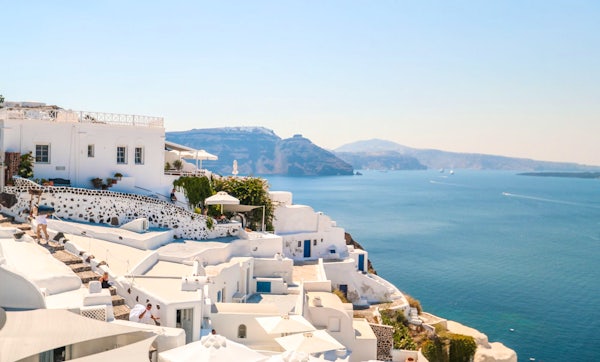
The Ionian Islands dash along the western side of Greece, going from the borderlands with Albania to the edges of the Peloponnese. They are characterised by soaring cliffs of chalk-white stone, sun-blazed beaches, and pebble coves. The history is fascinating, with Corfu especially bringing tastes of Italy through its Baroque architecture and old Venetian fortresses. But, mainly, Ionia is a vacationer's dream – still seas and picture-perfect bays abound from Zante to Kefalonia.

Stringing out through the northern Aegean Sea over the far side of Attica from the Cyclades and Athens, the Sporades take a bit of influence from the Greek highlands. They're crumpled by big Greek mountains and clad in fragrant pine and fir forests. That makes for wonderful walking, but also rocky shorelines that draw in scuba folk with the promise of 30-metre visibilities. Skiathos is probably the best known of the bunch, but undiscovered Alonnisos is becoming more and more popular with adventure travellers.
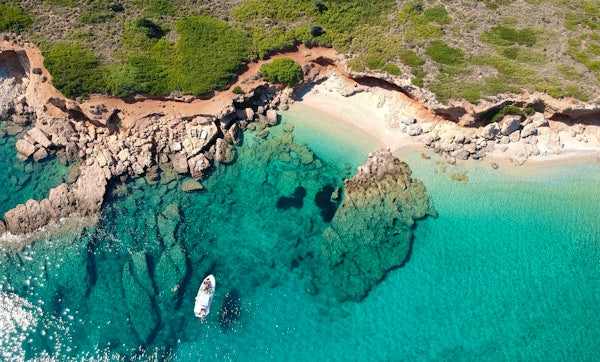
The 15 main Dodecanese Islands are about as close as it's possible to get to Turkey while staying in Greece. Expect cobalt blue waters and towns painted in pastel colours, with Orthodox church domes blazing in teal overhead. The mainstays in these parts are the ultra-historic land of Rhodes (hello, UNESCO castles from the Middle Ages!), the sleepy harbour isle of Symi, and hedonistic Kos.
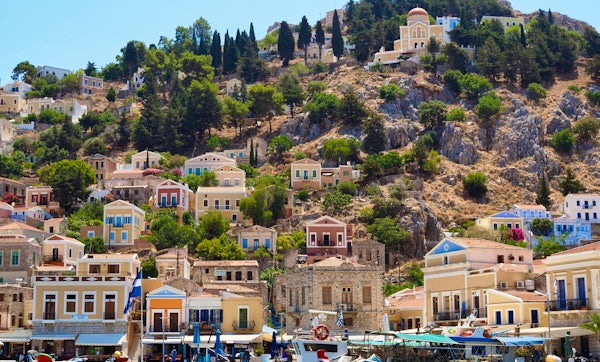
The Saronic Islands lie in the Saronic Gulf, just west and south of Athens. Some of them can be accessed in less than 30 minutes out of the capital, which is why these are among the busiest island-hopping destinations in Greece come the high summer. They're also a good choice for winter trips, because the ferry links run throughout the low season, and many can be accessed by car. Hydra really steals the show with its stoop stone cottages and mystical Orthodox monastery, but we love Poros, a yachter's hotspot with a charming marina area riddled with tavernas.
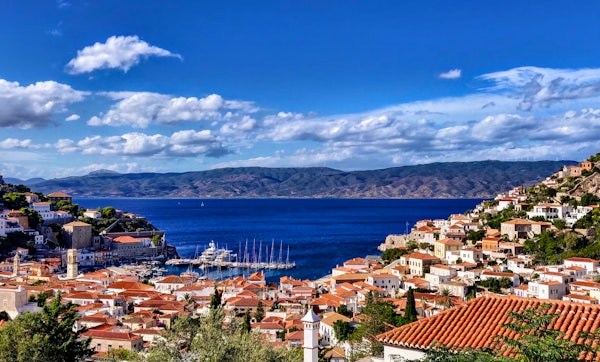
The top Greek islands to visit
There are just so many tempting destinations on the menu when it comes to Greek island hopping. In fact, half the planning is sometimes in deciding which isle is the most tempting of all, from the sheer-cut cliffs of Santorini to the goat-stamped gorges of Crete…
The poster boy for Greek island hopping, Santorini is a regular on travel brochures and postcards. It's a jaw-dropping place that was actually once a complete volcano cone. Ancient eruptions shattered it to pieces, though. What's left is an incredible crater flooded by the Aegean Sea, with cinnamon-hued cliffs rising vertically from the water to whitewashed towns. It's something everyone should see at least once.
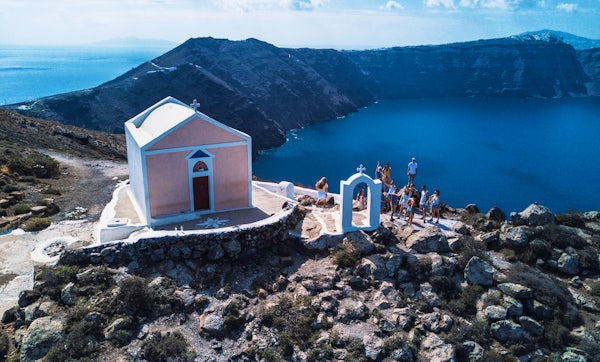
Mykonos has a reputation for being the good-time island of the Cyclades chain. Chic bistros serving fusion food give way to elegant villas with infinity pools in these parts. Most people head for the west coast, where Mykonos Town and its famous windmills head up a stretch of shoreline that includes beaches like Psarrou – a jet-setter enclave – and Paradise Beach – where the best parties in Greece happen!
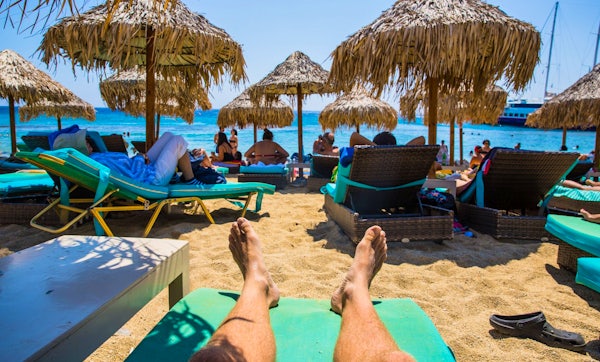
Zakynthos has one of the most eye-wateringly wonderful lengths of shoreline in the country. Yep, the west coast here is scored by vertiginous cliffs of shimmering white stone and beaches that can only be reached by boat. The best of them is Shipwreck Beach – have you ever seen anything like it? Meanwhile, the west and east coasts are softer and dotted with resorts, most notably Laganas – a bumping 18-30s party town! Plan your trip to this must-visit spot with our ultimate guide to Zakynthos.

Far away on the edge of the Aegean and Libyan seas, Crete is like nowhere else in the country. It's the largest island of the lot, measuring 160 miles from one end to the other. You won't even have to go island hopping if you come here, because there's so much to see – the tropical-esque lagoon of Balos, the pink-sanded beaches of Elafonisi, the summits of the White Mountains dotted with wild thyme and goat herds. That said, Crete is a good starting point for getting to the Cyclades, as direct boats go from Heraklion to Santorini.
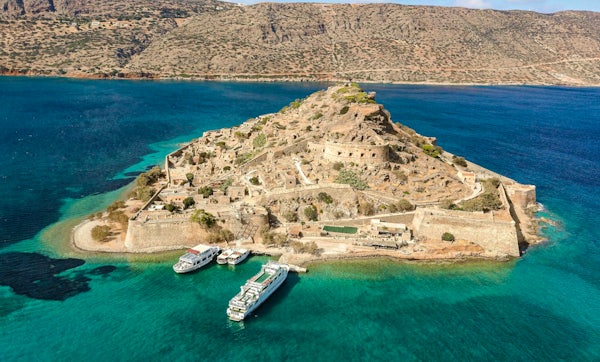
Mountains rise in the heart of Corfu to mark it out on the very frontier of Greece. One step more and you'd be in the Adriatic Sea, another to the east and you'd wash up in Albania. The location means there's an interesting mix of culture and history, with old Greek temple ruins meeting tavernas that serve Italian- and Balkan-tasting fare. Corfu is also hailed as a true looker – just check out the idyllic bluffs of Palaiokastritsa and the sculpted headlands of the Sidari capes.
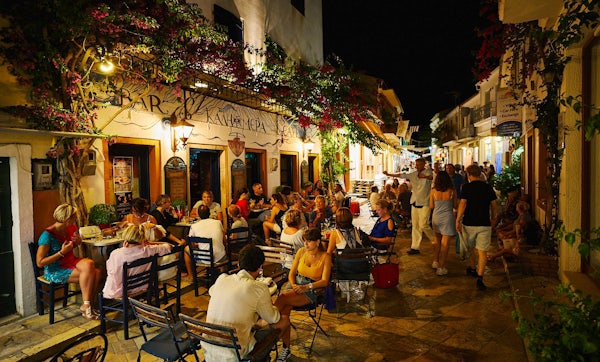
The main island of the Dodecanese will enthral with its rich Crusader history and beautiful hinterland. You could spend whole stops on your Greek island hopping trip wandering the UNESCO-tagged fortresses of Rhodes Town. Or you can whiz out along the coast roads on the hunt for beaches in Lindos and Prasonisi. Oh, and there's loads of partying thanks to thumping Faliraki, which is one of the liveliest resort towns of all. Check out our ultimate guide to Rhodes and get planning!
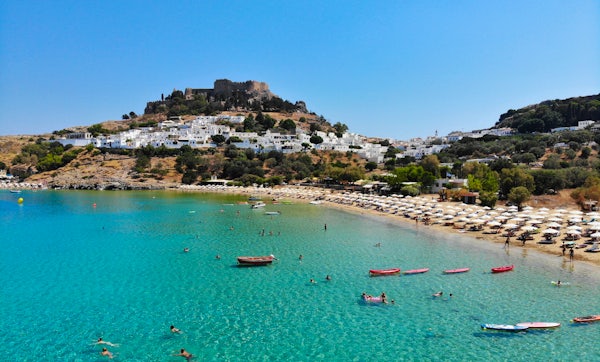
Paros acts as the central hub of the Cyclades islands. If you're doing your Greek island hopping on public ferries, there's a good chance you'll disembark here before hitching an onward ride to Milos, Santorini, Folegandros, Sifnos, Mykonos – you name it! But Paros deserves some time on its own. Dive into the Panagia Ekatontapiliani church from the 4th century for 400-year-old icons. Head to Lefkes for tavernas strewn with bougainvillea. Laze on the golden powders of Kolymbithres. It's hardly a chore!
